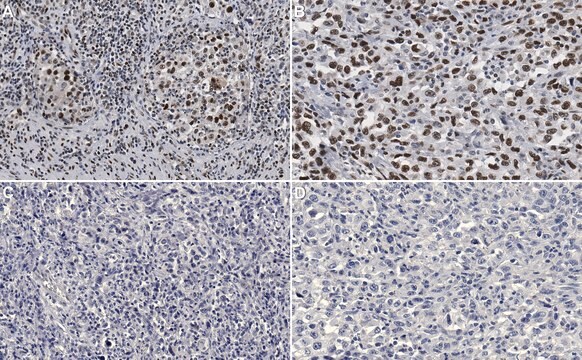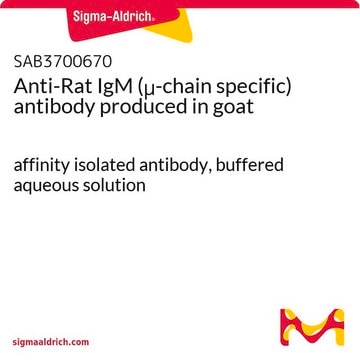一般說明
We are committed to bringing you greener alternative products, which adhere to one or more of The 12 Principles of Green Chemistry.This antibody is Preservative-free, produced without the harm or sacrifice of animals and exceptionally stable to allow for ambient shipping and storage if needed and thus aligns with "Waste Prevention", "Designing Safer Chemicals" and "Design for Energy Efficiency".
Click here for more information.
ZooMAb® antibodies represent an entirely new generation of recombinant monoclonal antibodies.
Each ZooMAb® antibody is manufactured using our proprietary recombinant expression system, purified to homogeneity, and precisely dispensed to produce robust and highly reproducible lot-to-lot consistency. Only top-performing clones are released for use by researchers. Each antibody is validated for high specificity and affinity across multiple applications, including its most commonly used application. ZooMAb® antibodies are reliably available and ready to ship when you need them.
特異性
Clone 1H13 is a ZooMAb® Rabbit recombinant monoclonal antibody that specifically detects CREB isoform 2 (CREB-A) phosphorylated on serine 133.
免疫原
KLH-conjugated linear peptide corresponding to 14 amino acids surrounding phosphoserine 133 in isoform 2 of human CREB (CREB-A).
應用
Quality Control Testing
Evaluated by Western Blotting in lysate from Phorbol-12-Myristate-13-Acetate (PMA) treated HeLa cells.
Western Blotting Analysis (WB): A 1:1,000 dilution of this antibody detected phospho-CREB (Ser133) in lysate from HeLa cells serum starved overnight and treated with Phorbol-12-Myristate-13-Acetate (PMA; 200 nM), but not in untreated cells.
Tested applications
Immunohistochemistry (Paraffin) Analysis: A 1:100 dilution from a representative lot detected phospho-CREB (Ser133) in human stomach cancer tissue sections.
Affinity Binding Assay:: A representative lot of this antibody bound phospho-CREB (Ser133) peptide with a KD of 1.0 x 10-12 in an affinity binding assay.
Peptide Inhibition Assay: Target band detection in HeLa cell lysate was prevented by preblocking of a representative lot with the phopho-CREB (Ser133) peptide, but not the corresponding non-phosphopeptide.
Immunocytochemistry Analysis: A 1:100 dilution from a representative lot detected p-CREB (Ser133) in HeLa cells treated with Phorbol-12-Myristate-13-Acetate (PMA).
Note: Actual optimal working dilutions must be determined by end user as specimens, and experimental conditions may vary with the end user
標靶描述
Cyclic AMP-responsive element-binding protein 1 (UniProt: P16220; also known as CREB-1, cAMP-responsive element-binding protein 1) is encoded by the CREB1 gene (Gene ID: 1385) in human. CREB is a phosphorylation-dependent transcription factor that stimulates transcription upon binding to the DNA cAMP response element (CRE; TGACGTCA) as a dimer. It is essential for the activation of a number of immediate early genes. It also plays a key role in promoting neuronal survival, differentiation, proliferation, and neurite outgrowth. Transcription activation is reported to be enhanced by the TORC coactivators. CREB has four main functional domains: a C-terminal basic/leucine zipper domain (bZIP; aa 269-327), the Kinase Inducible Domain at the N-terminal (KID; aa 87-146), and two glutamine-rich domains (Q1, and Q2). The Q1 and Q2 domains provide transactivation function in the absence of cAMP signaling and synergize with KID and bZIP to confer full activity to CREB in response to cAMP. CREB is phosphorylated on serine 133 by protein kinase A, which promotes the recruitment of the co-activator CREB-binding protein(CBP) and p300 that increases the transcription of CREB-dependent genes. CREB is also phosphorylated on serine 133 by mitogen- and stress-activated kinase 1/2 (MASK 1/2) in cells in response to the activation of MAPK signaling. Phosphorylation of CREB is sufficient to induce cellular gene expression in response to cAMP, however, additional promoter-bound factors are required for target gene activation by CREB in response to mitogen or stress signals, indicating the presence of components in the CREB pathway that discriminate between different types of inputs. This ZooMAb® recombinant monoclonal antibody, generated by our propriety technology, offers significantly enhanced specificity, affinity, reproducibility, and stability over conventional monoclonals. (Ref.: Wang, H., et al. (2018). Front. Mol. Neurosci. 11; 255; Naqvi, S., et al. (2014) Biochem. J. 458(3); 469-479; Mayr, B., and Montiminy, M. (2001). Nat. Rev. Mol. Cell Biol. 2(8); 599-609).
外觀
Purified recombinant rabbit monoclonal antibody IgG, lyophilized in PBS, 5% Trehalose, normal appearance a coarse or translucent resin. The PBS/trehalose components in the ZooMAb formulation can have the appearance of a semi-solid (bead like gel) after lyophilization. This is a normal phenomenon. Please follow the recommended reconstitution procedure in the data sheet to dissolve the semi-solid, bead-like, gel-appearing material. The resulting antibody solution is completely stable and functional as proven by full functional testing. Contains no biocide or preservatives, such as azide, or any animal by-products. Larger pack sizes provided as multiples of 25 μL.
重構
300 μg/mL after reconstitution at 25 μL per vial. Please refer to guidance on suggested starting dilutions and/or titers per application and sample type.
儲存和穩定性
Recommend storage of lyophilized product at 2-8°C; Before reconstitution, micro-centrifuge vials briefly to spin down material to bottom of the vial; Reconstitute each vial by adding 25 μL of filtered lab grade water or PBS; Reconstituted antibodies can be stored at 2-8°C, or -20°C for long term storage. Avoid repeated freeze-thaws.
法律資訊
ZooMAb is a registered trademark of Merck KGaA, Darmstadt, Germany
免責聲明
Unless otherwise stated in our catalog or other company documentation accompanying the product(s), our products are intended for research use only and are not to be used for any other purpose, which includes but is not limited to, unauthorized commercial uses, in vitro diagnostic uses, ex vivo or in vivo therapeutic uses or any type of consumption or application to humans or animals.








